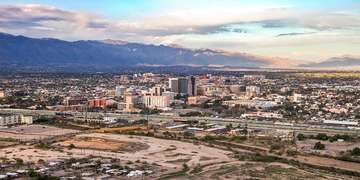UA’s Landmark Commitment to Carbon Neutrality
With a new renewable energy strategy, the University of Arizona aims for more than just sustainability. It has its sights set on radical leadership in the field.

From rising temperatures to extreme weather events, the consequences of climate change are dire — and happening at a faster rate than previously thought. As outlined in the October 2018 report from the United Nations’ scientific panel on climate change, the outlook calls for ambitious social, economic and lifestyle changes to reduce greenhouse gas emissions. In response to the deepening crisis, the University of Arizona has set a bold goal: a commitment to being carbon neutral by 2040.
The goal is part of the UA’s participation in the American College & University Presidents’ Climate Commitment as orchestrated by the organization Second Nature, says Peter Dourlein, UA assistant vice president for planning, design and construction. It also represents a dramatic acceleration of efforts: In 2007, when the UA first signed on, the goal for carbon neutrality was 2050. In 2015, the UA renewed its commitment with an additional pledge to integrate climate resiliency in partnership with the Tucson community. In 2018, the UA advanced its carbon neutrality goal to 2040 and set a goal of carbon neutrality in Scope 2 emissions by 2025 (Scope 1, 2 and 3 emissions are explained below).
Carbon neutrality is an inherent part of the university’s renewable energy strategy, which is integral to the UA’s land grant mission and institutional priorities. “As a university with a very large environmental footprint,” says Trevor Ledbetter, director of the UA’s Office of Sustainability, “it is critical for us to leverage our size and influence to accelerate novel solutions in the space — most ideally by utilizing our campus itself as a living, learning laboratory for our faculty and students.”

The UA plans to achieve carbon neutrality by reducing emissions directly from campus operations, mitigating indirect emissions from purchased electricity and reducing other indirect emissions like campus commutes.
Focusing on the Future
Even with the UA’s legacy of pioneering innovation and leadership, this ambitious goal is a tall order. The challenge will require a complex and sustained team effort. The university’s Planning, Design and Construction team is collaborating with the UA’s Office of Sustainability and other partners to drive efforts, focusing broadly on two main areas: reducing greenhouse gases and the carbon footprint from existing operations, and offsetting the carbon that can’t be eliminated. “Those offsets will come in the form of green energy: wind and solar,” Dourlein says. “We are working on both and plan to accomplish our goals early.”
Ahead of releasing a planned Decarbonization and Resiliency Plan, the Sustainability Office outlined key steps on the road map to carbon neutrality. Scope 1 emissions, which result directly from campus operations, will be addressed almost entirely through reduction. “By 2040, we hope to take both of our co-generational turbines offline and, through technological advances, electrify our entire campus fleet,” Ledbetter says. Scope 2 emissions, or indirect emissions that result from the university’s purchased electricity, will be mitigated through the renewable energy agreement — likely within the next couple of years, says Ledbetter.
Scope 3 emissions — other indirect emissions such as campus commutes and university air travel — are more complex but will involve a combination of reductions and offsets. “We hope to reduce the number of single-driver commuters to campus over time, which, combined with greater electrification, will help to lower our carbon footprint,” Ledbetter says. The purchase of carbon offsets will also drive sustainability forward throughout the university’s procurement and supply chains.
Everything Old Is Green Again
The UA is building facilities and infrastructure that are among the highest in energy efficiency while also being conducive to productive living, learning, research and play. The university is making significant improvements to operations and central plants that reduce water and energy use, resulting in reduced greenhouse gas emissions. “At the same time,” Dourlein says, “we are exploring potential on- and off-site large-scale renewable energy investments, such as solar and wind, to offset greenhouse gases.”
As standout examples, Ledbetter points to the Health Sciences & Innovation Building, which was recently rated LEED Gold and received a Three Globes certification from Green Globes, and the Environment and Natural Resources 2 Building, which incorporates energy-efficient heating and cooling, rainwater harvesting and low-flow faucets to use significantly less energy and water than comparable buildings.
As Dourlein notes, not building is often the most environmentally friendly choice of all. “With growth, sometimes we must build new spaces, but we always first consider repurposing an existing building,” he says. “The greenest building is the one you never need to build. Repurposing and renovating is a greener way to go when that is an option.”
Though the goal is ambitious, Dourlein is optimistic. “I like to think of sustainability as more of a verb than a noun,” he says. “It requires action, not just in one facet but all facets of our lives.”
Leaping into a low-carbon future makes sense for the university, the wider community and the planet at large. Future generations stand to gain from this critical effort.
